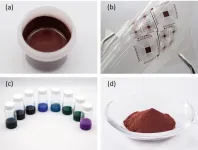(Press-News.org) CAMBRIDGE, MA -- Hundreds of robots zip back and forth across the floor of a colossal robotic warehouse, grabbing items and delivering them to human workers for packing and shipping. Such warehouses are increasingly becoming part of the supply chain in many industries, from e-commerce to automotive production.
However, getting 800 robots to and from their destinations efficiently while keeping them from crashing into each other is no easy task. It is such a complex problem that even the best path-finding algorithms struggle to keep up with the breakneck pace of e-commerce or manufacturing.
In a sense, these robots are like cars trying to navigate a crowded city center. So, a group of MIT researchers who use AI to mitigate traffic congestion applied ideas from that domain to tackle this problem.
They built a deep-learning model that encodes important information about the warehouse, including the robots, planned paths, tasks, and obstacles, and uses it to predict the best areas of the warehouse to decongest to improve overall efficiency.
Their technique divides the warehouse robots into groups, so these smaller groups of robots can be decongested faster with traditional algorithms used to coordinate robots. In the end, their method decongests the robots nearly four times faster than a strong random search method.
In addition to streamlining warehouse operations, this deep learning approach could be used in other complex planning tasks, like computer chip design or pipe routing in large buildings.
“We devised a new neural network architecture that is actually suitable for real-time operations at the scale and complexity of these warehouses. It can encode hundreds of robots in terms of their trajectories, origins, destinations, and relationships with other robots, and it can do this in an efficient manner that reuses computation across groups of robots,” says Cathy Wu, the Gilbert W. Winslow Career Development Assistant Professor in Civil and Environmental Engineering (CEE), and a member of a member of the Laboratory for Information and Decision Systems (LIDS) and the Institute for Data, Systems, and Society (IDSS).
Wu, senior author of a paper on this technique, is joined by lead author Zhongxia Yan, a graduate student in electrical engineering and computer science. The work will be presented at the International Conference on Learning Representations.
Robotic Tetris
From a bird’s eye view, the floor of a robotic e-commerce warehouse looks a bit like a fast-paced game of “Tetris.”
When a customer order comes in, a robot travels to an area of the warehouse, grabs the shelf that holds the requested item, and delivers it to a human operator who picks and packs the item. Hundreds of robots do this simultaneously, and if two robots’ paths conflict as they cross the massive warehouse, they might crash.
Traditional search-based algorithms avoid potential crashes by keeping one robot on its course and replanning a trajectory for the other. But with so many robots and potential collisions, the problem quickly grows exponentially.
“Because the warehouse is operating online, the robots are replanned about every 100 milliseconds. That means that every second, a robot is replanned 10 times. So, these operations need to be very fast,” Wu says.
Because time is so critical during replanning, the MIT researchers use machine learning to focus the replanning on the most actionable areas of congestion — where there exists the most potential to reduce the total travel time of robots.
Wu and Yan built a neural network architecture that considers smaller groups of robots at the same time. For instance, in a warehouse with 800 robots, the network might cut the warehouse floor into smaller groups that contain 40 robots each.
Then, it predicts which group has the most potential to improve the overall solution if a search-based solver were used to coordinate trajectories of robots in that group.
An iterative process, the overall algorithm picks the most promising robot group with the neural network, decongests the group with the search-based solver, then picks the next most promising group with the neural network, and so on.
Considering relationships
The neural network can reason about groups of robots efficiently because it captures complicated relationships that exist between individual robots. For example, even though one robot may be far away from another initially, their paths could still cross during their trips.
The technique also streamlines computation by encoding constraints only once, rather than repeating the process for each subproblem. For instance, in a warehouse with 800 robots, decongesting a group of 40 robots requires holding the other 760 robots as constraints. Other approaches require reasoning about all 800 robots once per group in each iteration.
Instead, the researchers’ approach only requires reasoning about the 800 robots once across all groups in each iteration.
“The warehouse is one big setting, so a lot of these robot groups will have some shared aspects of the larger problem. We designed our architecture to make use of this common information,” she adds.
They tested their technique in several simulated environments, including some set up like warehouses, some with random obstacles, and even maze-like settings that emulate building interiors.
By identifying more effective groups to decongest, their learning-based approach decongests the warehouse up to four times faster than strong, non-learning-based approaches. Even when they factored in the additional computational overhead of running the neural network, their approach still solved the problem 3.5 times faster.
In the future, the researchers want to derive simple, rule-based insights from their neural model, since the decisions of the neural network can be opaque and difficult to interpret. Simpler, rule-based methods could also be easier to implement and maintain in actual robotic warehouse settings.
###
This work was supported by Amazon and the MIT Amazon Science Hub.
END
New AI model could streamline operations in a robotic warehouse
By breaking an intractable problem into smaller chunks, a deep-learning technique identifies the optimal areas for thinning out traffic in a warehouse.
2024-02-27
ELSE PRESS RELEASES FROM THIS DATE:
Smartphone app uses AI to detect depression from facial cues
2024-02-27
Dartmouth researchers report they have developed the first smartphone application that uses artificial intelligence paired with facial-image processing software to reliably detect the onset of depression before the user even knows something is wrong.
Called MoodCapture, the app uses a phone's front camera to capture a person's facial expressions and surroundings during regular use, then evaluates the images for clinical cues associated with depression. In a study of 177 people diagnosed with major depressive disorder, the app correctly identified early symptoms of depression with 75% accuracy.
These results suggest the technology could be publicly ...
First DNA study of ancient Eastern Arabians reveals malaria adaptation - study
2024-02-27
People living in ancient Eastern Arabia appear to have developed resistance to malaria following the appearance of agriculture in the region around five thousand years ago, a new study reveals.
DNA analysis of the remains of four individuals from Tylos-period Bahrain (300 BCE to 600 CE) - the first ancient genomes from Eastern Arabia - revealed the malaria-protective G6PD Mediterranean mutation in three samples.
The discovery of the G6PD Mediterranean mutation in ancient Bahrainis suggests that many people in ...
Pitt study shows bariatric surgery is more effective than medical and lifestyle interventions for diabetes control and remission
2024-02-27
PITTSBURGH, Feb. 27, 2024 – Bariatric surgery is more effective than medical and lifestyle modifications for achieving long-term Type 2 diabetes control and remission, according to new research led by a University of Pittsburgh School of Medicine surgeon-scientist and published today in JAMA.
In the largest and longest randomized follow-up study to date, the researchers also found that bariatric surgery improved cholesterol and triglyceride levels more effectively than did medical and lifestyle modifications. Since diabetes and cholesterol are important risk factors for heart disease, the management of both may contribute to fewer heart attacks, strokes and other complications.
“This ...
Long-term outcomes of medical management vs bariatric surgery in type 2 diabetes
2024-02-27
About The Study: After 7 to 12 years of follow-up, individuals originally randomized to undergo bariatric surgery compared with medical/lifestyle intervention had superior glycemic control with less diabetes medication use and higher rates of diabetes remission.
Authors: Anita P. Courcoulas, M.D., of the University of Pittsburgh, is the corresponding author.
To access the embargoed study: Visit our For The Media website at this link https://media.jamanetwork.com/
(doi:10.1001/jama.2024.0318)
Editor’s Note: Please see the article for additional information, including other authors, author contributions and affiliations, conflict ...
Changes in health care workers’ economic outcomes following Medicaid expansion
2024-02-27
About The Study: In this study, only health care workers in higher-earning occupations (e.g., registered nurses, physicians, and managers) experienced increases in annual income after state-level Medicaid expansion, which has been shown to improve health care organization finances. These findings suggest that improvements in health care sector finances may increase economic inequality among health care workers, with implications for worker health and well-being.
Authors: Sasmira Matta, M.H.S., of the University of Pennsylvania in Philadelphia, is the corresponding author.
To access the embargoed study: ...
Socioeconomic status, palliative care, and death at home among patients with cancer before and during covid-19
2024-02-27
About The Study: The findings of this study of 173,000 adult patients who died with cancer suggest that the COVID-19 pandemic was associated with amplified socioeconomic disparities in death at home and specialized palliative care delivery at the end of life. Future research should focus on the mechanisms of these disparities and on developing interventions to ensure equitable and consistent specialized palliative care access.
Authors: Camilla Zimmermann, M.D., M.P.H., Ph.D., of the Princess Margaret Cancer Centre in Toronto, is the corresponding ...
Routine fecal occult blood screening and colorectal cancer mortality in Sweden
2024-02-27
About The Study: This study of routine screening with fecal occult blood testing found a 14% decrease in colorectal cancer mortality associated with screening. The true association of screening with reduced mortality is expected to be higher due to some coexistence of testing in the control group and colorectal cancer deaths diagnosed more than two years after screening.
Authors: Johannes Blom, M.D., Ph.D., of the Karolinska Institutet in Stockholm, is the corresponding author.
To access the embargoed study: Visit our For The ...
Au@Cu7S4 Yolk@Shell nanocrystals set new hydrogen production activity record under visible and near infrared irradiation
2024-02-27
The sunlight received by Earth is a mixed bag of wavelengths ranging from ultraviolet to visible to infrared. Each wavelength carries inherent energy that, if effectively harnessed, holds great potential to facilitate solar hydrogen production and diminish reliance on non-renewable energy sources. Nonetheless, existing solar hydrogen production technologies face limitations in absorbing light across this broad spectrum, particularly failing to harness the potential of NIR light energy that reaches Earth.
Recent research has identified that both Au and Cu7S4 nanostructures exhibit a distinctive optical characteristic known as localized surface plasmon resonance (LSPR) (Fig.1). ...
Press program now available for the world's largest physics conference
2024-02-27
The American Physical Society’s March Meeting begins next week with presentations on new research in climate science, medicine, biological physics, quantum information, superconductivity, condensed matter, and more. The conference will be in person in Minneapolis and online everywhere March 3-8.
Press Kit
There are no press conferences planned for this year’s program. However, tip sheets about newsworthy presentations are now available in the March Meeting press kit. Registered journalists and public information officers will also receive emails with press information daily for the duration of the meeting.
Press Room
In-person press registrants ...
Development of a thick-film conductive ink suitable for large-area, large-current printed electronics
2024-02-27
1. NIMS, Sumitomo Metal Mining Co., Ltd. (based in Minato City, Tokyo), N.E. CHEMCAT CORPORATION (based in Minato City, Tokyo) and Priways Co., Ltd. (a NIMS-founded startup based in Tsukuba, Ibaraki) have jointly developed a thick-film, electrically conductive ink suitable for printing electronic circuits and sensors on the surfaces of films and other substrates to manufacture printed electronics. Sumitomo Metal Mining and Priways displayed the ink during the 38th Nepcon Japan exhibition to be held from January ...
LAST 30 PRESS RELEASES:
Ancient teeth are treasure troves of data on Iron Age lifestyles
Avocados may become easier to grow in India—but not if global emissions remain high
Pregnant women with IBD show heightened inflammation in vaginal mucosa
Underwater photos show seabirds, seals and fish interacting with a tidal turbine in Washington State
1 in 5 surveyed UK adults who have experienced the death of a pet report it as more distressing than experienced human deaths, with significant rates of prolonged grief disorder symptoms also being re
Polyester microfibers in soil negatively impact the development of cherry tomato plants in experiments, raising concerns over the potential effect of high levels of such contaminants
LGBTQ+ adults may be around twice as likely to be unemployed or to report workforce non-participation compared to heterosexual adults, per large representative Australian survey
Horses can smell fear: In experiments where horses smelled sweat from scared humans, they reacted to scary and sudden events with increased fear and reduced human interaction
New synaptic formation in adolescence challenges conventional views of brain development
Scientists identify target to treat devastating brain disease
Oliver Zielinski selected as Fellow of The Oceanography Society
Has progress stalled on gender equality at work?
Quantum simulator sheds light on how nature moves energy in systems like photosynthesis and solar conversion
Can a hashtag help prevent atrocities? Study shows social media can be a powerful tool
The American Ornithological Society (AOS) announces the winner of the 2025 Wesley Lanyon Award
Woolly rhino genome recovered from Ice Age wolf stomach
An earthquake on a chip: New tech could make smartphones smaller, faster
New research shows how AI tools are expanding individual capabilities while contracting scientific attention
A nanomaterial flex — MXene electrodes help OLED display technology shine, while bending and stretching
Global research team uncovers mechanism by which metabolites guide cellular decisions
Work hours, stress, and burnout among resident physicians
Quality of life of parents of premature infants
Should younger and older people receive different treatments for the same infection?
Scientists discover how fast the world’s deltas are sinking
Scientists demonstrate first-time use of AI for genetic circuit design
Copenhagen researchers make the front page of Nature: Solving the mystery of the universe's ‘little red dots’
Seoul National University-Drexel University team achieves world's highest efficiency fully stretchable OLEDs with 17% external quantum efficiency
Hydrogel cilia set new standard in microrobotics
Application of orthogonal CNOP-I in a convection-allowing ensemble prediction system based on CMA-MESO for improving extreme precipitation skill
Study suggests bamboo has ‘superfood’ potential
[Press-News.org] New AI model could streamline operations in a robotic warehouseBy breaking an intractable problem into smaller chunks, a deep-learning technique identifies the optimal areas for thinning out traffic in a warehouse.


